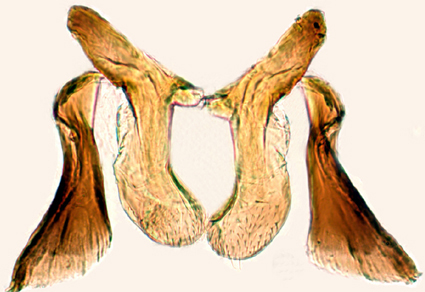Abstract
Illustrated description of adult male, as well as DNA barcoding, of Thalassomya paraskevae sp. nov. in comparison with close related species T. frauenfeldi Schiner from coast of the Black Sea are provided. Interspecific p-distances using gene COI 5P between T. paraskevae sp. nov. and T. frauenfeldi from Madeira (Portugal) were 8.94%. Divergence between described species and T. frauenfeldi collected near the type locality (Friuli Venezia-Giulia, Italy) using COI 3P were 7.72%. Obtained values corresponds to species level.
References
- Ashe, P. & O’Connor, J.P. (2009) A World Catalogue of Chironomidae (Diptera). Part 1. Buchonomyiinae, Chilenomyiinae, Podonominae, Aphroteniinae, Tanypodinae, Usambaromyiinae, Diamesinae, Prodiamesinae and Telmatogetoninae. Irish Biogeographical Society & National Museum of Ireland, Dublin, 445 pp.
- Neubern de Oliveira, C.S., Navarro, M.A.S. & Trivinho-Strixino, S.T. (2013) Thalassomya gutae sp. n., a new marine chironomid (Diptera: Chironomidae: Telmatogetoninae) from the Brazilian coast. Zootaxa, 3701 (5), 589–595. https://doi.org/10.11646/zootaxa.3701.5.4
- Cranston, P.S., Hardy, N.B. & Morse, G.E. (2012) A dated molecular phylogeny for the Chironomidae (Diptera). Systematic Entomology, 37, 172–88. https://doi.org/10.1111/j.1365-3113.2011.00603.x
- Folmer, O., Black, M., Hoeh, W., Lutz, R. & Vrijenhoek, R. (1994) DNA primers for amplification of mitochondrial cytochrome c oxidase subunit I from diverse metazoan invertebrates. Molecular Marine Biology and Biotechnology, 3, 294–299.
- Kumar, S., Stecher, G. & Tamura, K. (2016) MEGA7: Molecular Evolutionary Genetics Analysis version 7.0 for bigger datasets. Molecular Biology and Evolution, 33 (7), 1870–1874. https://doi.org/10.1093/molbev/msw054
- Makarchenko, E.A., Semenchenko, A.A. & Palatov, D.M. (2022a) Redescription of the Caucasian endemic Diamesa caucasica Kownacki et Kownacka (Diptera: Chironomidae: Diamesinae). Zootaxa, 5159 (3), 445–450. https://doi.org/10.11646/zootaxa.5159.3.9
- Makarchenko, E.A., Semenchenko, A.A. & Palatov, D.M. (2022b) Taxonomy of Diamesa steinboecki group (Diptera: Chironomidae: Diamesinae), with description and DNA barcoding of new species. I. Subgroups steinboecki and longipes. Zootaxa, 5125 (5), 483–512. https://doi.org/10.11646/zootaxa.5125.5.2
- Makarchenko, E.A., Semenchenko, A.A. & Palatov, D.M. (2023) Fauna and taxonomy of Diamesinae (Diptera: Chironomidae) from the Caucasus, with a morphological description and DNA barcoding of new taxa and a discussion of diagnostic problems for Diamesa Meigen and Pseudodiamesa Goetghebuer. Zootaxa, 5271 (2), 313–328. https://doi.org/10.11646/zootaxa.5271.2.6
- Michailova, P. (1976) An additional B chromosome in Thalassomyia frauenfeldi Schiner (Chironomidae, Diptera) from Bulgaria’s Black Sea coast. Doklady bolgarskoi akademii nauk, 29 (2), 267–269.
- Montagna, M., Mereghetti, V., Lencioni, V. & Rossaro, B. (2016) Integrated Taxonomy and DNA Barcoding of Alpine Midges (Diptera: Chironomidae). PLoS ONE, 11 (3), e0149673. https://doi.org/10.1371/journal.pone.0149673
- Puillandre, N., Brouillet, S. & Achaz, G. (2021) ASAP: assemble species by automatic partitioning. Molecular Ecology Resources, 21 (2), 609–620. https://doi.org/10.1111/1755-0998.13281
- Saitou, N. & Nei, M. (1987) The neighbor-joining method: a new method for reconstructing phylogenetic trees. Molecular Biology and Evolution, 4 (4), 406–425. https://doi.org/10.1093/oxfordjournals.molbev.a040454
- Schiner, J.B. (1856) Anmerkung zu dem im Bande V, pag. 13 dieser Verhandlungen abgedruckten aufsatze Frauenfeld’s Beitrag zur Insekten-Geschichte. Verhandlungen des zoologisch-botanischen Vereins in Wien, 6, 215–224.
- Simon, C., Frati, F., Beckenbach, A., Crespi, B., Liu, H. & Flook, P. (1994) Evolution, weighting, and phylogenetic utility of mitochondrial gene sequences and a compilation of conserved polymerase chain reaction primers. Annals of the Entomological Society of America , 87, 651–701. https://doi.org/10.1093/aesa/87.6.651
- Valkanov, A. (1949) Thalassomyia frauenfeldi Schiner ot Cherno More. Trudove na morska biologichna stantsiya v Varna, 14, 103–112. [in Bulgarian]
- Valkanov, A. & Michailova, P. (1974) Untersuchungen über den Karyotypus und Chromosomen Polymorphismus bei Thalassomyia frauenfeldi Schiner (Diptera, Chironomidae) von der bulgarischen Schwarzmeerküste. Bulletin de l’Institut de Zoologie et Musée Academie Bulgare des Science, 40, 5–16.
- Wirth, W.W. (1947) Notes on the genus Thalassomyia Schiner, with description of two new species (Diptera: Tendipedidae). Proceedings of the Hawaiian entomological Society, 13, 117–139.


